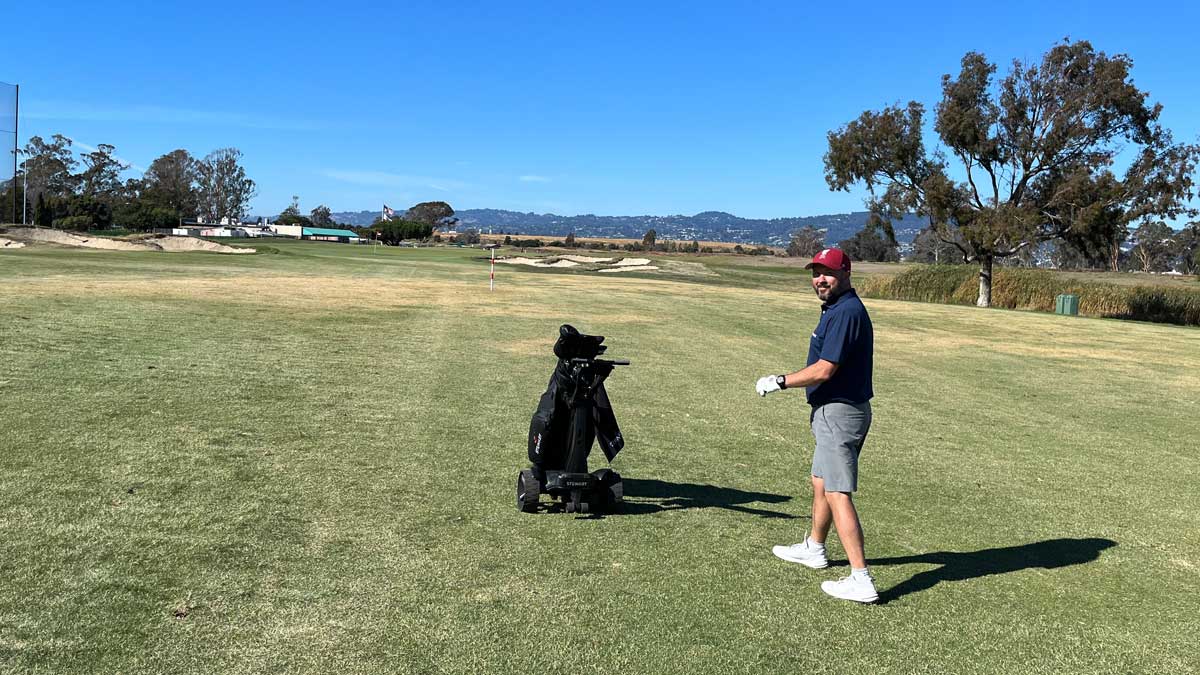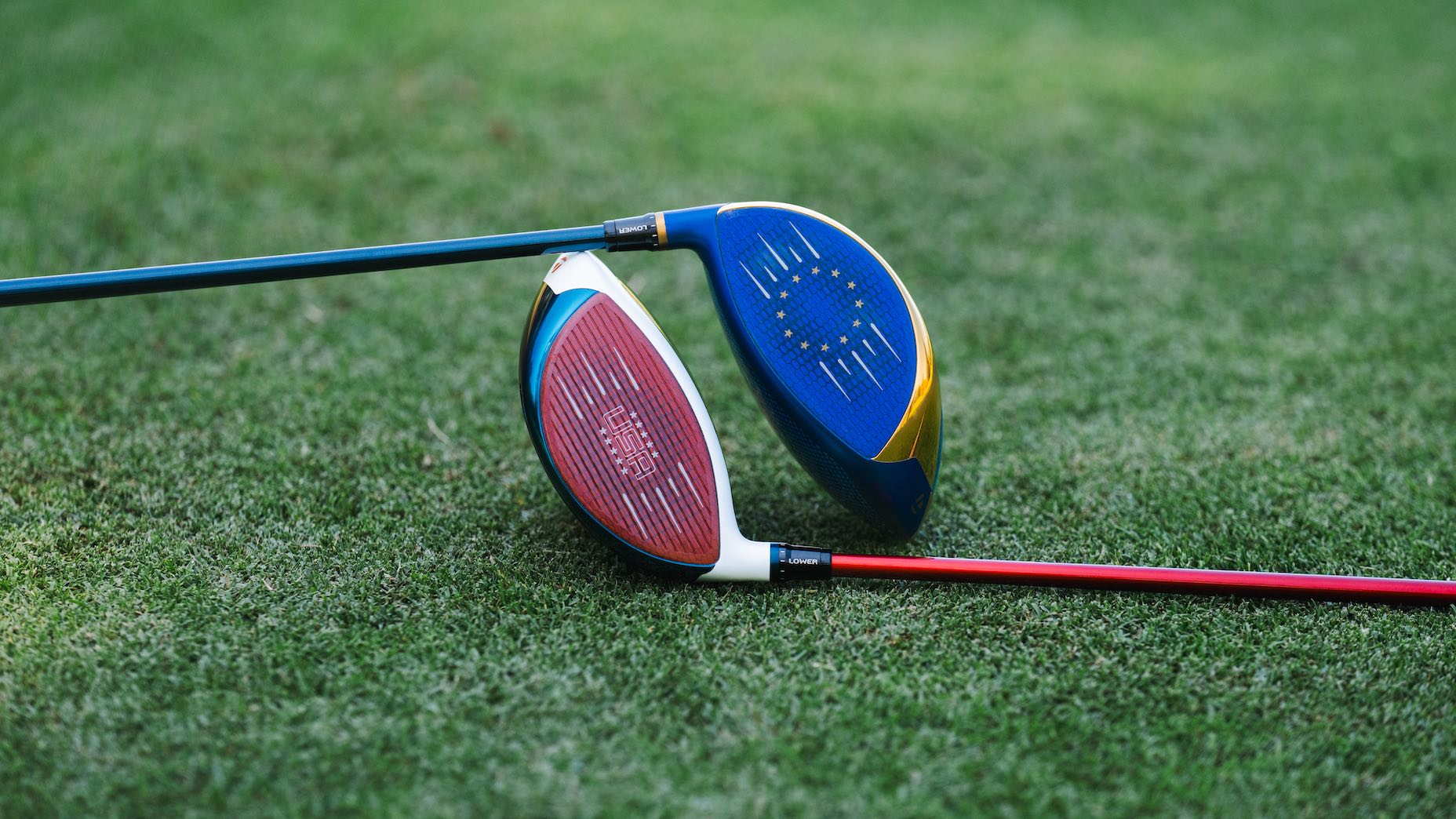
Mark Stewart during a recent round.
Josh Sens
Cart golf was a 20th-century American invention, and while buggies have since spread to courses around the world, they retain a firm grip on the U.S. golf scene.
Of the 25.6 million golfers in the United States, roughly two-thirds ride carts, according to surveys by the National Golf Foundation.
Those are not the stats in the game’s ancestral home.
“The phrase ‘walking golf’ isn’t used in the UK,” Mark Stewart said. “Because walking is pretty much how everybody plays.”
It was a sun-kissed afternoon in Northern California, and Stewart was breezing through a round at a Bay Area muni. Stewart favors walking, and not just because he’s English. His preference also stems from the business he is in.
His company, Stewart Golf, makes electric trolleys, designed to carry bags for those who play on foot.
Though walkers are in the minority in this country, the U.S. is Stewart’s largest and fastest-growing market, so he spends a lot time on these shores, trying to spread the word about a category — electric trolleys — that he says many golfers still don’t know exists. It can be a fine line, proselytizing without seeming pushy.
“I definitely don’t want to come across as the condescending Brit, telling people how they should play,” he said.
Stewart can sound moony when he talks about walking. He once penned a poem in honor of the practice. “Here’s to the walkers/we feel the ground under our feet/we breathe the air, the solitude, the company…“ But spiritual enrichment is not his only pitch. There is also the matter of exercise science.
Over the years, experts from a range of academic fields have studied various ways of getting around the course, along with the potential benefits and drawbacks. Though not all the research has reached the same conclusions, this much is consensus: Walking a course is better exercise than riding, and it comes with a host of potential upsides, including greater muscular-skeletal stability and better cardiovascular health. For golfers in reasonably decent shape, walking has also been shown to improve focus and lower scores.
For someone in Stewart’s line of work, such findings make good talking points. But on his recent stateside swing, Stewart was bent on sharing news about another set of walking-related data. The numbers he repeated to anyone who’d listen came from a 2022 study, published in the European Journal of Sports Science, that measured energy expenditure among competitive golfers in different walking modes: carrying their bags, and using electric and push trolleys.
If you’ve always assumed that carrying a bag provides a better workout than using a trolley, you’re not alone. That’s a widespread perception. But according to the study, it’s not the case.
More about those findings in a minute.

Josh Sens
First, though, some background on the study itself.
It was led by Graeme Close, a professor of human physiology at Liverpool John Moores University who also serves as a nutritionist for the DP World Tour and the European Ryder Cup team. Working with Dr. Andrew Murray, chief medical officer for the European Tour Performance Institute, Close followed 16 aspiring professional golfers over three competitive rounds on the same course. All the golfers wore monitors that tracked their heart rates and activity levels.
While golfers in each category burned different amounts of calories, those differences were so slight (688 calories-burned over 18 holes for golfers who carried compared to 663 calories for those who used an electric caddie, and 756 calories for those who pushed) as to be negligible, the study found. When it came to energy expenditure, the researchers concluded that there were “no meaningful” differences between carrying or using a trolley.
The takeaway: If exercise is what you’re after, what matters is that you walk, not how you transport your clubs. You’ll burn a similar amount of calories whichever way you go.
“This is an important observation for recreational golfers,” Close and Murray wrote, “who may want to pursue golf for health reasons, yet find carrying a golf bag uncomfortable.”
Along with actual energy expenditure, the study also looked at Ratings of Perceived Energy (PTE). That is, how hard the golfers felt that they were working. Turns out feel and real are not the same. Golfers who carried had the highest levels of PTE. They felt like they were working harder, even though they weren’t.
Did that affect their performance? The study did not address that question, which, the researchers noted, was something that “could be explored in future research.”
Stewart is not an expert on exercise science or sports performance. He’s an engineer-turned-entrepreneur who readily concedes to his obvious bias. He’s big on walking. He’s certain that it’s better for you, and he’s pretty sure it helps you play better, too. But he’s not an absolutist. He understands that some golfers will always prefer to ride, and that others may have physical limitations that prevent them from walking.
“You also have courses that require carts,” Stewart said. “And given how far apart greens and tees are on some courses, I can understand why they’d make that a requirement.”
The afternoon was wearing on and Stewart’s round was winding down. He was walking with one of his own trolleys, which he’d set on “follow,” so that it trailed behind him faithfully like a golf-world R2-D2, minus the irritating beeps and chirps.
“My feeling is, the more people walking, the better,” Stewart said. “But I’m not looking to argue with anyone.”
He had another round scheduled the following day but was due soon after to be back in England. There are several ways to cross the Atlantic. But walking isn’t one of them. Stewart had opted for a commercial flight.









